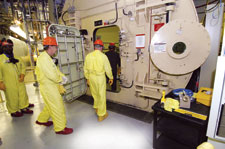 |
| Transition. Workers enter airlock to start work in Pickering Unit 1s reactor building. |
Nuclear powers death knell has been sounded continually since the 1979 scare at Three Mile Island and the 1986 catastrophe at Chernobyl but the operators of nuclear powerplants have stubbornly declined to participate in their own funerals. Instead, they steadily upgraded and uprated their plants and improved their capacity factors.
When the last new reactor in the U.S., 1,121-MW Watts Bar 1, entered service in 1996, the countrys nuclear-generation capacity hit its historic high of 100,784 MW. Since then, units totaling 3,348 MW have been retired, but the countrys nuclear capacity in 2004 was still 99,209 MW. Output actually has grown 17%, to 788.6 billion kWh in 2004, and the capacity factor has risen from 76.2% to 90.1%. These are not the vital signs of a dying industry.
Now, a second wave of nuclear power expansion promises to further boost capacity as owner-operators return mothballed reactors to service. The effort has not been without pain. The Tennessee Valley Authoritys restart of Browns Ferry units 2 and 3 in the early 1990s was dogged by delays, controversy and cost escalations. Ontario Power Generation Inc.s restart of Pickering A Unit 4 came at the cost of a two-year schedule overrun, a tripling of the budget and the jobs of every senior officer in the company.
| Related Links |
| Ontario Utility Shakes Off Troubles and Invigorates Nuclear Program |
But utilities have learned from those painful programs. Pickering A Unit 1 now is in restart following its successful overhaul, completed last month on time and on budget). And Browns Ferry Unit 1s restart also is on time and on budget, because its project team is applying lessons from the two earlier restarts.
These and other restarts will ensure nuclear power production remains in the mix until the next generation of reactors can draw support for construction. Industry leaders in the U.S. think they can bring an entirely new nuclear unit on line by 2015, with a target construction start of 2010.
(Photo courtesy of Ontario Power Generation)

Post a comment to this article
Report Abusive Comment